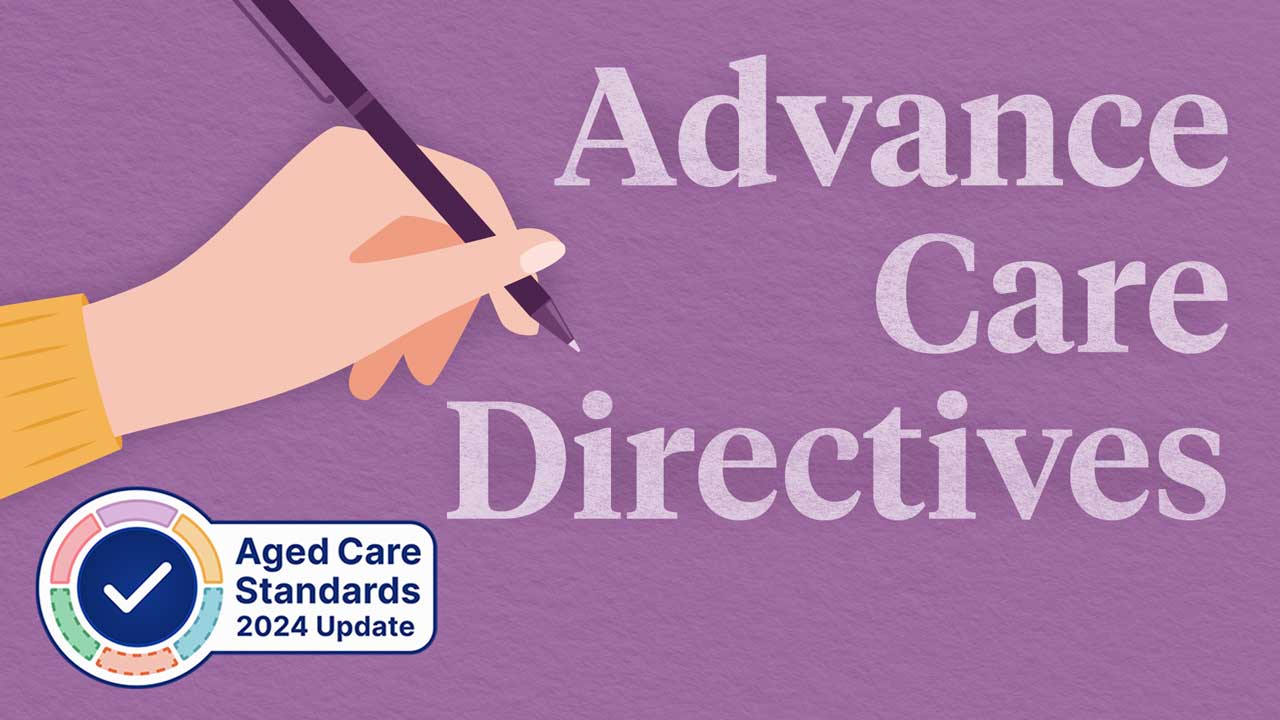When the potential health outcome for a patient is poor, there may be confusion about what interventions should or should not be performed if the patient does not have the capacity to make an informed decision.
An advance care directive is a critical form of documentation that communicates the patient’s instructions and wishes in such a situation, taking the burden of decision-making off loved ones.
In the case of sudden deterioration, it’s essential to know where a patient’s advance care directive can be found and understand how it works.
What is an Advance Care Directive?
An advance care directive is a legally binding document that outlines a patient’s directions and/or preferences for medical treatment. It is used in the event of incapacitation where the patient does not have the decision-making capacity to communicate their wishes (Better Health Channel 2018).
An advance care directive is written by the patient themself.
When a patient does not have decision-making capacity, healthcare providers will consult the patient’s advance care directive and use it to guide clinical decisions (Better Health Channel 2018).
Although advance care directives are part of end-of-life care, they are an important document for everyone to consider implementing regardless of their current medical condition, as emergencies can strike at any time (Alderslade 2019).
Ideally, an advance care directive should be completed before the patient becomes unwell so that their treatment plan and wishes are clear if care escalates.
Any person over the age of 18 with decision-making capacity is able to write an advance care directive. A person can also write a new advance care directive and replace their existing one at any time (DoHaAC 2024).

What is Decision-Making Capacity?
All adults are assumed to have decision-making capacity unless proven otherwise (OPA 2022).
Generally, in order for a patient to have decision-making capacity, they must:
- Be able to comprehend and retain the information needed to make a decision. This includes information about the treatment, alternatives, consequences and risks of the decision.
- Be able to use and evaluate this information as part of their decision-making process.
(End of Life Law in Australia 2022)
Note that while this is the definition of capacity under common law, each state and territory may have additional requirements and specific tests used to determine a patient’s capacity (End of Life Law in Australia 2022).
What Does an Advance Care Directive Include?
A patient may choose to write an instructional directive, values directive or both in their advance care directive:
- An instructional directive gives consent or refusal to medical treatments specified by the patient. These directions are legally binding and must be followed by healthcare staff.
- A values directive lists values and preferences of the patient that must be taken into consideration by the medical treatment decision-maker. The patient may list their preferences, life goals and preferred outcomes.
(OPA 2022)
The patient may also choose to appoint a medical treatment decision-maker. This specified person will be granted the legal authority to make decisions on behalf of the patient if they become unable to do so themself (OPA 2022).

Why Write an Advance Care Directive?
A global study spanning 2 decades, 10 countries and 1.2 million patients found that 33% of older end-of-life care patients were receiving non-beneficial, invasive and unwanted interventions in their last two weeks of life (UNSW 2016).
An advance care directive empowers patients to inform the treatments they receive and communicate their wishes for the future rather than relying on loved ones to decide. It provides them peace of mind that their preferences will be respected in the event of incapacitation and prevents them from suffering unwanted interventions (Better Health Channel 2018).
How Do You Make an Advance Care Directive?
This will depend on the patient’s state or territory of residence, as each jurisdiction has individual forms and requirements. These can be found on the Advance Care Planning Australia website.
Advance Care Planning Under the Strengthened Aged Care Quality Standards
Standard 3: Care and Services - Outcome 3.1: Assessment and Planning of the strengthened Aged Care Quality Standards (Action 3.1.6) requires providers to have processes in place for advance care planning wherein:
- Older people are supported to discuss future medical treatments and care that aligns with their needs, goals, preferences, beliefs, culture, religion and traditions
- Older people are supported to write advance care planning documents if they wish to do so
- Older people are supported to designate a substitute decision-maker if they wish to do so
- Older people’s advance care planning documents are appropriately stored, managed, used and shared, including during care transitions.
(ACQSC 2024a)
Furthermore, Standard 5: Clinical Care - Outcome 5.7: Palliative and End-of-life care (Action 5.7.2) requires providers to support older people, together with their family, carers and substitute decision-makers, to review advance care planning documents to ensure they are up-to-date with the older person’s current needs, goals and preferences (ACQSC 2024b).
Relevant Legislation
Although the legislation and requirements for advance care directives differ between states and territories, the National Framework for Advance Care Planning Documents (2021) outlines the goals each jurisdiction should strive for in developing policy and practice.
Advance care directives are governed by the following state and territory legislation:
- Medical Treatment (Health Directions) Act 2006 (ACT)
- Advance Personal Planning Act 2013 (NT)
- Powers of Attorney Act 1998 (Qld)
- Advance Care Directives Act 2013 (SA)
- Guardianship and Administration Act 1995 (Tas)
- Medical Treatment Planning and Decisions Act 2016 (Vic)
- Guardianship and Administration Act 1990 (WA)
Advance care directives are recognised by common law in New South Wales (Advance Care Planning Australia 2024).
Consent and Refusal
Under Australian legislation and common law, all patients with decision-making capacity have the right to make informed decisions about medical treatment and must give consent to any treatment they receive (Health.vic 2023).
Informed consent means that:
- The patient has decision-making capacity
- The patient consents voluntarily (without coercion, manipulation or undue pressure)
- The patient consents to the same treatment as the one that is given.
(ELDAC 2023)
Patients with decision-making capacity also have the legal right to refuse any medical treatment, even if it will result in death. A patient can refuse treatment for any reason, and healthcare staff must follow this decision; overriding this is a violation of the patient’s bodily integrity, and the offending healthcare worker may be subject to civil or criminal law (End of Life Law in Australia 2023).
By writing an advance care directive, a patient can specify treatments they consent to and/or refuse, and these instructions will be adhered to if the patient’s decision-making capacity is lost.

Where Should an Advance Care Directive Be Stored?
- With the patient
- At the patient’s hospital
- At the patient’s residential aged-care facility
- With the patient’s general practitioner and treating specialist
- On My Health Record
- With the patient’s medical treatment decision-maker, and
- With the patient’s family and/or close friends.
(Better Health Channel 2018)
Conclusion
When working with patients, It is crucial to establish whether they have an advance care directive, where it is located and when it should be used.
Additionally, you must understand and adhere to patients’ legal and ethical rights in regard to consent.
Test Your Knowledge
Question 1 of 3
Jim has been in a serious accident and is taken to hospital, where healthcare staff are suggesting a treatment that would be beneficial to him. Jim is accompanied to the hospital by his wife Mary, who is his designated medical treatment decision-maker. Jim is currently awake but highly confused and having difficulty understanding what the medical staff are telling him. Who has the authority to decide whether Jim receives the treatment?
Topics
Further your knowledge
References
- Advance Care Planning Australia 2024, Advance Care Planning Laws in New South Wales, Advance Care Planning Australia, viewed 19 April 2024 https://www.advancecareplanning.org.au/law-and-ethics/state-and-territory-laws/advance-care-planning-laws-in-nsw
- Aged Care Quality and Safety Commission 2024a, Standard 3: Care and Services, Australian Government, viewed 19 April 2024, https://www.health.gov.au/resources/publications/strengthened-aged-care-quality-standards-august-2025?language=en
- Aged Care Quality and Safety Commission 2024b, Standard 5: Clinical Care, Australian Government, viewed 19 April 2024, https://www.health.gov.au/resources/publications/strengthened-aged-care-quality-standards-august-2025?language=en
- Alderslade, L 2019, ‘An Advanced Care Directive Can Offer Peace of Mind’, Aged Care Guide, 17 April, viewed 30 May 2023, https://www.agedcareguide.com.au/talking-aged-care/an-advanced-care-directive-can-offer-peace-of-mind
- Better Health Channel 2018, Advance Care Plans, Victoria State Government, viewed 30 May 2023, https://www.betterhealth.vic.gov.au/health/servicesandsupport/advance-care-plans
- Department of Health and Aged Care 2024, Advance Care Directive, Australian Government, viewed 19 April 2024, https://www.health.gov.au/topics/palliative-care/planning-your-palliative-care/advance-care-directive
- End of Life Directions for Aged Care 2021, Factsheet: Capacity and Consent to Medical Treatment, ELDAC, viewed 30 May 2023, https://www.eldac.com.au/tabid/5270/Default.aspx
- End of Life Law in Australia 2022, Capacity and Consent to Medical Treatment, Queensland University of Technology, viewed 30 May 2023, https://end-of-life.qut.edu.au/capacity
- End of Life Law in Australia 2023, Withholding and Withdrawing Life-sustaining Treatment for Adults, and Guardianship Law, Queensland University of Technology, viewed 30 May 2023, https://end-of-life.qut.edu.au/treatment-decisions/adults
- Health.vic 2023, Informed Consent and Presumption of Capacity, Victoria State Government, viewed 19 April 2024, https://www.health.vic.gov.au/mental-health-and-wellbeing-act-handbook/supported-decision-making/informed-consent-and-presumption
- Office of the Public Advocate (State of Victoria) 2022, Take Control, Victoria State Government, viewed 30 May 2023, https://www.publicadvocate.vic.gov.au/your-rights/your-healthcare/making-an-advance-care-directive
- University of New South Wales 2016, ‘Global Analysis Finds Unnecessary End-of-life Treatment in Hospitals is Widespread’, ScienceDaily, 27 June, viewed 30 May 2023, https://www.sciencedaily.com/releases/2016/06/160627124424.htm
 New
New 

